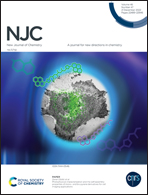A novel Ni/Co metal–organic framework with a porous organic polymer material as a ligand for a high-performance supercapacitor and a glucose sensor
Abstract
With the development of wearable diagnostic and therapeutic technology, numerous researchers have shown great interest in integrated bifunctional electrode materials with a supercapacitor and sensing performance. Herein, we report a hydrangea-like metal–organic framework (Ni/Co-DAP MOF) with porous organic polymer DAP, obtained through the Schiff-base reaction of 3,5-diaminobenzoic acid (DABA) and terephthalaldehyde (TPAL), as a ligand for a supercapacitor and a glucose sensor. Benefiting from the porous and conjugated structure of DAP, the Ni/Co-DAP MOF presents a high specific capacitance of 2200 F g−1 at a current density of 1 A g−1. The asymmetric supercapacitor (ASC) device Ni/Co-DAP MOF//AC ASC with the Ni/Co-DAP MOF as the positive electrode delivers an outstanding energy density of 100.11 W h kg−1 at a power density of 849.98 W kg−1 and exhibits an excellent capacitance retention of 94% after 5000 cycles. In addition, the Ni/Co-DAP MOF also demonstrates excellent glucose sensing performance, including a high sensitivity of 278 μA cm−2 mM−1 in the range of 1.67 μM–8.03 mM and a detection limit of 0.557 μM (S/N = 3). The excellent electrochemical performance of the Ni/Co-DAP MOF highlights the general relevance of our reasonable design with porous DAP as a ligand and expands its broad prospects for energy storage and electrochemical sensing.



 Please wait while we load your content...
Please wait while we load your content...